The volume of water in the bimetallic radiator section. Which bimetallic heating radiators are better and stronger - technical characteristics and tips for choosing radiators
Hello Dear blog readers! In general, bimetallic heating radiators appeared a very long time ago. They became popular due to the fact that they coped well with the function of heating the room without special costs from the outside. In our article we will analyze the positive and negative aspects of these radiators. We will also pay attention to the nuances of their installation, technical characteristics and other interesting points that are definitely worth mentioning.
Summary of this article:
Positive aspects of using bimetallic radiators
- It's worth starting with design. Bimetallic radiators tend to fit perfectly into virtually any residential interior. They do not have sharp corners and take up fairly little space. If required, there is always the opportunity to hide them inside the wall.
- These radiators have an excellent service life of approximately 25 years.
- Excellent for all heating systems.
- They withstand pressure very well. Even if in the heating system it rises to 30-40 atmospheres, this will not affect their strength in any way.
- They transfer heat well into the room, which will definitely prevent you from freezing in winter.
- Thanks to a specialized thermostat, you can virtually instantly change the temperature in the room.
- If any breakdown occurs, thanks to good design repairs can be carried out directly on site without the need for dismantling or turning off the water supply.
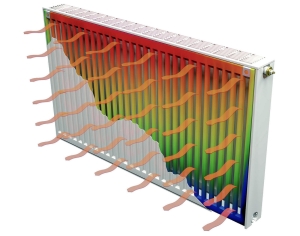
Disadvantages of bimetallic radiators
These radiators have much fewer disadvantages:
- Due to different expansion coefficient aluminum alloy and steel, over time the radiator may creak when heated.
- If a low-quality coolant is used, then rapid clogging of the pipes may occur.
- Price. It is significantly higher than, for example, analogues made of cast iron/steel/aluminium.
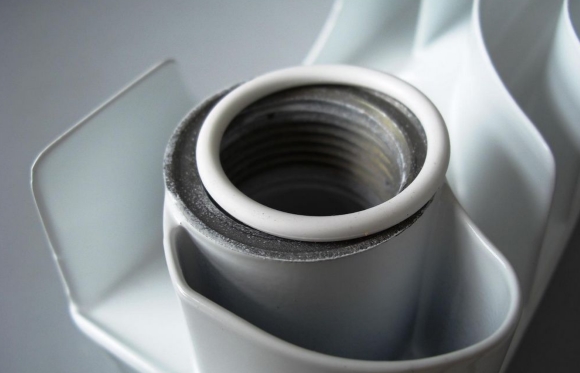
How to calculate the number of radiator sections?
You don't need to be a mathematician to make calculations. The formula is so simple that even people with a humanitarian mindset can handle it.
Before making calculations, find out the exact area of the room. The next step is to find out the production capacity of the radiator.
In order to find out the number of radiator sections (denoted by A), you need to multiply the area of the room (denoted by S) by 100 and divide by the power of the radiator (denoted by P). The diagram looks like this:
A = S×100÷P
For example, if the area of the room is 45 sq.m. and a radiator power of 200 watts we get the following:
A = 45×100÷200
A = 22.5

From this we can conclude that in order to heat a room well at 45 square meters we will need 22-23 radiator sections.
Installation (installation) of bimetallic heating radiators
The complete structure consists of pipes and, directly, the radiator itself. These two components are connected by spot welding. For these reasons, it is better to seek the help of highly qualified specialists who will do the work safely, efficiently and in the shortest possible time.
When installing bimetallic radiators experts advise using polypropylene pipes. This greatly simplifies the installation of the latter and minimizes the risk that the pipes may become clogged with unwanted deposits from the inside during operation.
Specifically, what you should know about installation:
- Installation occurs after preparing the workspace, marking and drilling the fasteners for the brackets.
- Install the radiator based on the distance from the floor to the bottom of the radiator. It is advisable to maintain this indicator in the region of 60-120 millimeters. This is done in order to achieve maximum heat transfer.
- Installation should be carried out strictly under the window space.
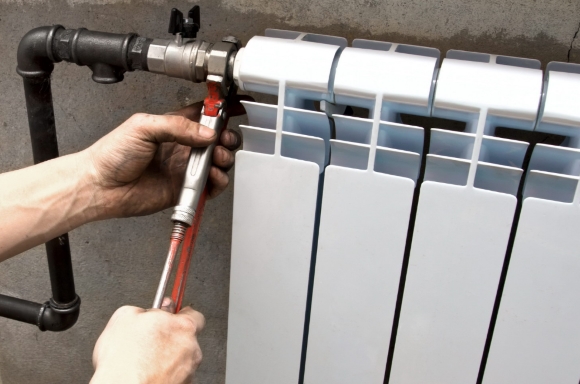
As for the technical part, you should follow these steps:
- When the markings are finished, holes are drilled for the brackets and secured with dowels and cement mortar.
- Then the radiator is equipped with a Mayevsky valve (it allows you to remove excess air from the system). It is also equipped with fittings and adapters in the place where the radiator connects to the pipes.
- The last steps are to equip the water riser with taps. Then the pipes are installed, which connects the radiator itself and the riser.
As you can see, installing a bimetallic radiator is not a complicated process if you correctly follow the step-by-step instructions.
Connection diagrams are divided into the following types:
- One-sided scheme. IN this option the pipe that supplies water to the radiator is connected to a special pipe, which is located on top of the radiator. In this case, the outlet pipe is mounted from below.
- Bottom diagram. It is used in cases where the heating system is hidden in the floor covering. In this case, the outlet and supply pipes are connected strictly from opposite sides to each other.
- The pattern is diagonal. Very good for a lot sectional radiators. The supply pipe is connected at the top of the radiator, and the outlet pipe at the bottom.

The diagrams, as you can see, sufficient quantity It is up to you to decide which scheme is more applicable to your circumstances.
Which bimetallic heating radiators are better and more durable?
In this part we will compare bimetallic radiators with semi-bimetallic ones. We will also pay attention to which of them is better - sectional or monolithic? This is a very important part, as it will allow you to approach your choice more intelligently and not spend extra money.
So which radiators are better - bimetallic or semi-bimetallic?
These two radiators differ in that in the first the core is welded and filled with aluminum, which prevents corrosion from occurring after some time. Secondly, the core contains two metals (steel and aluminum). Due to the mixture of these metals, although it is more susceptible to corrosion, it has higher heat transfer. As for the price, it is almost the same for both the first and the second.
What to choose? If service life is important to you, then the bimetallic option. If heat transfer is important, then semi-bimetallic. As you can see, everything is extremely simple.
What about the division based on sectional and monolithic characteristics?
Sectional ones differ from monolithic ones in that the former consist of so-called divided sections, while the latter are unified system without joints.

Most experts say that it is definitely worth choosing monolithic options. Monolithic ones win in terms of technical characteristics. They are as follows:
- Service life is about 50 years. For sectionals, this period is about 25 years.
- Withstand pressure up to 100 bar. In sectional ones there is only 25-35 bar (so low, as the section joints may not withstand)
The only thing in which both options are the same is the thermal power, which is equal to 100-200 watts per section.
Naturally, monolithic radiators are more expensive than sectional ones, but based on its advantages, it’s worth it.
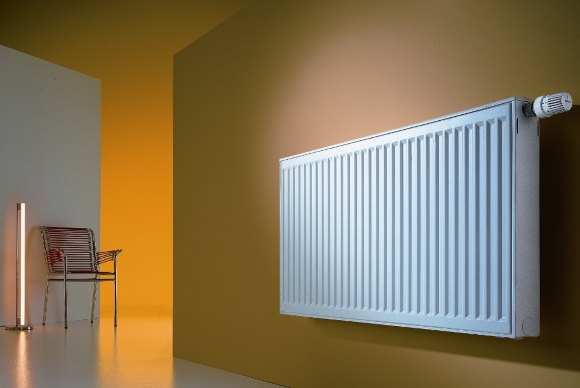
In order not to thoroughly study each manufacturer, we have compiled a table in which we present the average indicators for various signs for bimetallic radiators:
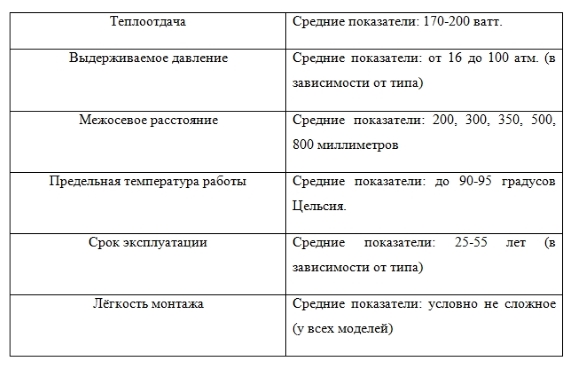
External design of bimetallic heating radiators
If you are concerned about the issue of design, then you should definitely know that each company has a unique design and is not similar to one another. On this moment There are a significant number of different companies producing bimetallic radiators. We will list the largest and most well-known to the average buyer. These are companies such as Sira (Italy), Royal (Italy), Rifar ( Russian Federation), Tenrad (Germany).
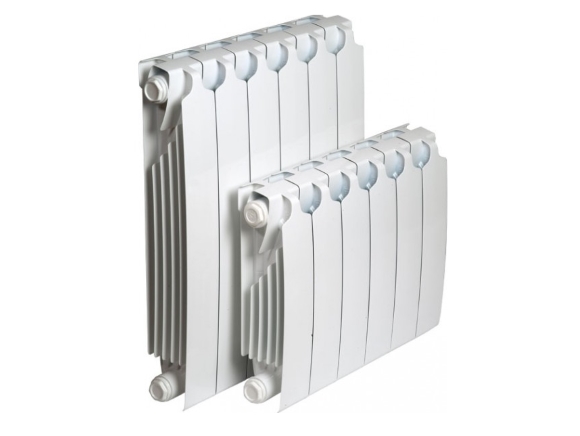

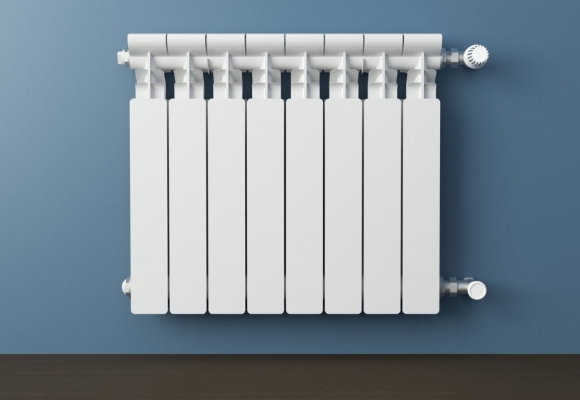
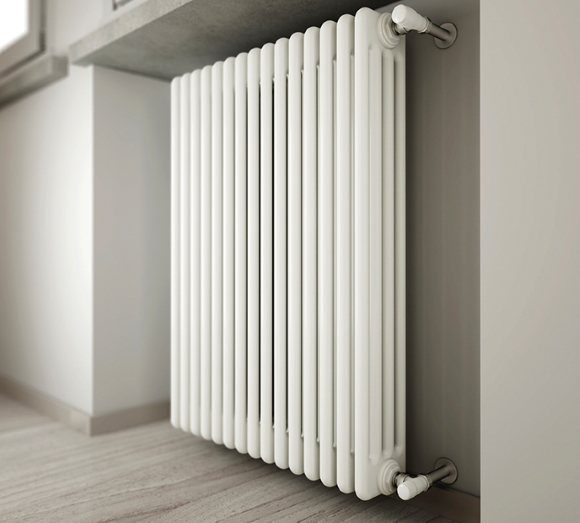
As you can see, in some ways they are all similar, but still they are distinguished by various features. Which one to choose is up to you. It all depends on your taste preferences.
What to look for when buying bimetallic radiators?
We figured out various technical characteristics, design and other tips. Now let’s specifically pay attention to what you should pay attention to when buying bimetallic radiators. This is a very important point that will allow you not to buy a low-quality product and not lose money again.
Here's a point-by-point breakdown of what you should pay attention to:
- Battery design. This is very important, since both the complexity of installation and the heat transfer from the radiator in the future depend on the design. Also the ability to add or remove sections.
- Distance between axles. The standard values are 35 and 50 centimeters. If you need more or less, then, naturally, you can find options with various non-standard values. But they are quite difficult to find.
- Exterior design radiator Bimetallic radiators are designed to be attached to straight surfaces. But if you may have any problems during installation (or you just want some non-standard solution), then modern market can offer different non-standard solutions. As a rule, almost every manufacturer will definitely have a couple of these in stock.
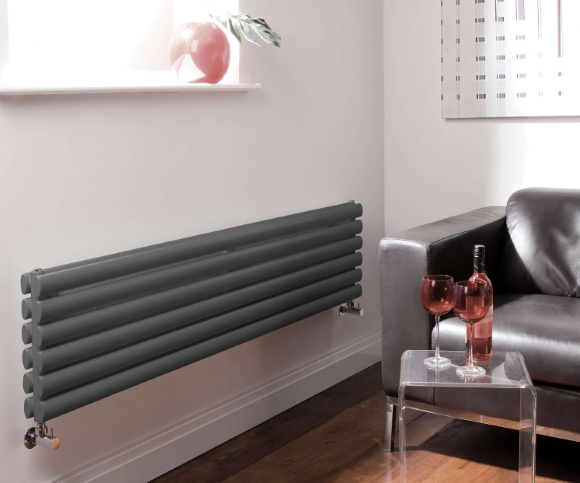
- Specifications. This point is clear. We talked about him above. Pay attention to specifications always worth it. After all, it is very easy to make a mistake with the choice and, for example, choose the wrong radiator size in relation to the footage of the heated room. Or make a mistake with the power and not get good heat transfer. Always remember the mathematical formula that we gave.
As practice shows, a bimetallic radiator gives off about the same amount of heat as its cast-iron counterpart. This figure fluctuates around 150-180 watts. This is written in detail in the passport of a particular model. We will again take as an example several of the most famous manufacturers that were discussed above and compile a small table with heat transfer parameters.

It is definitely worth saying that the higher the indicator, the better the heat transfer will be, so you should always choose models with higher indicators. Frankly speaking, the higher the indicator, the warmer the apartment will be during the heating season.
Which is better – solid or sectional bimetallic radiators?
There is no clear answer to this question. Solid bimetallic radiators consist of a “solid” core wrapped in a shell, while sectional ones, as we already know, consist of numerous sections.
You should buy sectional bimetallic radiators if the following things are important to you:
- High cooling and heating speed.
- Possibility of connection to a heating system with any type of pipes.
- Adjustment of heat transfer power by removing or adding sections.
- Light weight, which is a pleasant feature during installation.
Solid bimetallic radiators should be chosen for the following reasons:
- They can withstand pressure many times greater than sectional ones.
- Less susceptible to corrosion (which occurs during the non-heating season)
- They have greater tightness.
- It is very difficult to cause mechanical damage.
Experts advise choosing solid radiators. This is exactly the case if you are going to carry out installation at home. Sectional ones are well suited for office and other public spaces. At home, strength and service life are important. You don’t want to accidentally flood your neighbors or constantly have to repair your heating system, do you?
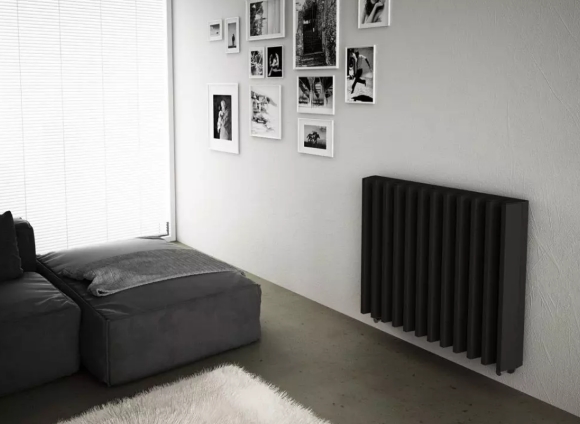
At the end of this voluminous article, we will summarize some results. We looked at the positive and negative aspects of bimetallic radiators. We learned how to correctly calculate the number of sections in order to achieve proper heat transfer. We paid attention to the installation and connection diagrams of the latter. Issues of design, size, nuances when choosing and others were not ignored. As you can see from all of the above, the competent choice of bimetallic radiators is another task that should be approached with the utmost rigor. After all, this is one of those things that will make your home comfortable even in the coldest months and therefore you should not neglect all the tips that we have listed. If you follow everything that has been said, it will bring joy and save your family’s budget for many decades. Stay warm!
For many years, the question of choosing radiators did not arise at all, because apart from cast iron “accordions”, they simply did not make other radiators.
Today the market is flooded with new models and different manufacturers.
The design of convectors is constantly being improved, new materials and combinations of materials are being added.
Bimetallic batteries have become the “gold standard” in their sector. They have absorbed the advantages of two metals and are successfully used by homeowners.
What are “bimetallic heating radiators”? Technical characteristics, design features and assistance with selection.
The metals most often used to make bimetallic radiators are steel and aluminum.
The weak point of steel is low heat transfer. Aluminum is short-lived due to increased sensitivity to corrosive processes.
By using these metals together, the developers have ensured that their radiators have high heat transfer, withstand high pressure and are more durable.
The design of a separate section of such a radiator is a steel base of two horizontal tubes connected by a thin vertical stand. The tubes are threaded (left on one side, right on the other) to connect the battery sections.
The coolant is in contact only with this steel internal part. The heat is then transferred to an aluminum heat exchanger, which distributes the heat throughout the room. The outer aluminum layer has complex design and a thoughtful air flow pattern.
Another option for bimetallic radiators is copper and aluminum. Unlike the first ones, they are not sectional, but solid.

Inside the aluminum body there is a copper coil. Inner surface copper pipes smooth, little susceptible to corrosion and can be used with any coolant.
With a stainless steel core, the batteries are not afraid of complete discharge of water.
Installing bimetallic radiators is no different from installing any other batteries. Recommendations for installation in SNiP 3.05.01-85
Specifications
Bimetallic heating radiators - which ones are better to choose? Here are the five main parameters of radiators:
- Heat transfer, or power.
- Operating pressure.
- Dimensions.
- Capacity of one section.
- Coolant temperature.
Now let's take a closer look.
- Heat dissipation/power. Characterizes the amount of heat that one section of the battery gives off. Measured in Watts. Bimetallic radiators have good performance - around 190 - 200 W. The manufacturer indicates the data obtained during testing.
- Pressure. What load can the batteries withstand without bursting? Indicated in the technical passport. Happens operating pressure, testing and destructive, i.e. critical. It is measured in atmospheres or megapascals. For bimetallic batteries operating pressure ranges from 15-40 atm., or 1.5-4 MPa.
- Dimensions. Includes width, height, depth of one section, weight and center distance. The weight of the radiator does not affect its operation, but it is much easier to install lightweight batteries. The distance from the center of the inlet to the center of the outlet manifold is the center-to-center distance. It is important to know this so that you do not have to redo the pipes of the heating system. For example, 560x80x100 mm. 3kg, 500mm (the most common indicator).
- Capacity of one section. How much water or other coolant is placed in one section. The larger the capacity, the larger area surface that gives off heat. In addition, narrower sections of batteries are less resistant to pressure surges.
- Coolant temperature. What temperature of water will not harm the battery. The indicator may include pH. For example, 130 0 C, pH – 8.3-9.5.
Any bimetallic batteries are light enough that they can even be hung on drywall.
How to choose the right one
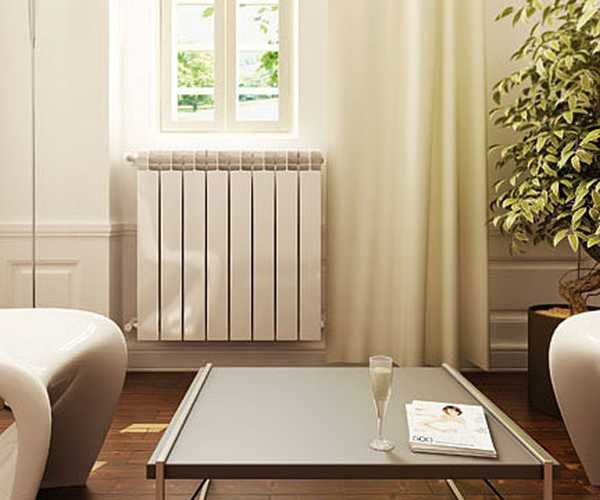
When choosing a radiator, you need to take into account some parameters of the device and make simple calculations.
For heating in a private house, radiators with any minimum pressure are suitable.
For centralized heating, it is worth purchasing batteries with maximum pressure. Because systems often experience surges and drops, and at the beginning heating season, when checking, water is supplied to the pipes at a pressure exceeding normal by more than 1 atm.
Russian manufacturers modestly set their batteries to 16 atm. But they can withstand pressure three times greater than this.
But in general, it is desirable that the pressure in the system be 1-2 atm. Less than the radiator operating pressure.
You need to know what will be poured into the radiator. If you have central heating, find out what quality the water is and what temperature it is.
The height is selected individually according to the location. As a rule, from the floor to the desired distance from the window sills. Best option:
- From the wall – 3cm;
- From the floor and window sill - 10 cm each.
Although there are models that fit perfectly into the interior in an unusual way: as a frame for a large flowerpot with flowers, or in the form of curtains along the entire height of the wall.
Batteries can be with top and bottom connection. The latter are sometimes more expensive due to the fact that it is more convenient to install a thermostatic valve to them.
Take a closer look at models that are symmetrical (top and bottom; back and front). They are easier to install and can be turned over and twisted. And even if some part is accidentally scratched, you can simply turn it towards the wall.
Calculation of the number of sections
Calculation formula for the number of sections of bimetallic heating radiators: N=P x (100:TO).
- N - number of sections;
- P – room area;
- TO – Section heat transfer.
Let's say we have a room of 18 m2. The calculation will look like this:
N=18 x (100:200 W).
This makes 9 sections.
Advantages and disadvantages
Bimetallic radiators have many advantages:
- Pressure resistance.
- Resistant to water hammer.
- Possibility of installation in apartments and houses.
- High heat dissipation.
- Durability.
- Smooth inner surface.
- Compatibility with pipes made of any material.
- The sectional structure allows you to dial right size batteries.
- A protective coating that eliminates the need to paint batteries.
- Wide selection of design solutions.
Steel-to-steel joints are more reliable than aluminum joints.
The murmur of water, which often accompanies the operation of radiators, is present in bimetallic models only during the heating stage. Subsequently, the device operates silently.
If water flows slowly through the pipes, sediment and debris will inevitably accumulate in the radiators. Bimetallic radiators can be disassembled, which means they can be cleaned.
Flaws:
- Does not tolerate air well in coolants;
- And the main thing is prices. Bimetallic heating radiators are more expensive than any other (the cost of one section is from 450 to 700 rubles).
There is also a “weak point” - intersectional connections. After prolonged use, the gaskets in them will need to be replaced.
Batteries in modern house an integral part of the heating system. But for heating to be effective, you need to choose the right radiators. The technical characteristics of bimetallic heating radiators are positive, and therefore they are very popular. This type of radiator got its name because of its double-layer walls, which consist of two different metals. But today more and more new models of bimetallic radiators are appearing on the market, the characteristics of which are increasingly improved.
Rice. 1Specifications
The main characteristics of bimetallic heating devices should be noted; they can be divided into several main points:
- The heat output of this radiator is quite large, namely about 100-190 W. The aluminum shell has good heat transfer.
- Radiator pressure indicator. The operating pressure of bimetallic radiators can be up to 40 atm. This is explained robust construction, that is, a steel core. In order for this core to rupture, the pressure must be at 90 atm. We can conclude that a bimetallic heating radiator, the pressure characteristics of which are quite high, can also work in extreme situations, namely during water hammer.
- Temperature. This figure can reach up to 1000C or more.
- The bimetallic battery has high resistance to corrosive processes. According to this parameter, the most effective are devices with a core made of of stainless steel.
- Important characteristic bimetallic radiators is their aesthetic appearance. The shape and front panel of the radiators suits any interior.
Reliability and efficiency are the main characteristics of bimetallic devices.
But it should be borne in mind that these qualities are fully inherent in the products of well-known manufacturers that have proven themselves in the market. For example, Global Style (Italy), Sira (Italy), Rifar (Russia), Royal thermo (Italy). Such manufacturers, as a rule, provide a guarantee for heating devices for 10-15 years. Radiators from well-known manufacturers are not only of high quality, they have an elegant appearance and small parameters.
Device
The complete set of bimetallic heating radiator is two-layer:
- Inner layer is a steel core consisting of an upper and lower collector, which has H-shape(Fig. 2). The collectors are connected by a pipe with a heat pipe - it is through this pipe that the coolant flows. Internal metal structure Ideal for heating systems, that is, it holds pressure well.
- Outer layer– this is a decorative shell, which is made of several plates (in the form of sections) or in the form of a solid panel (Fig. 2).
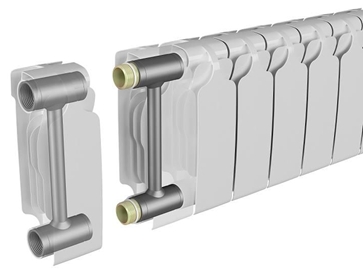 Rice. 2 Bimetallic design
Rice. 2 Bimetallic design radiator
Sectional design bimetallic device heating system has sealed fastenings inside. This design has a significant advantage: the radiator can be enlarged (increased) or reduced.
The thermal characteristics of a bimetallic device also lie in the materials of manufacture. There are 2 types:
- Copper and aluminum. This type of radiator has enough good characteristics. Copper has high thermal conductivity and is not susceptible to corrosion processes. This device also has great power.
- Steel and aluminum. This option for manufacturing radiators can be without a core in the form of pipes, but simply with steel-reinforced channels. This option has greater heat transfer. And there are no blockages in this design.
Bimetallic heating radiators are equipped with channels with a small cross-country diameter. This means that a small amount of coolant is required. This is a significant plus for the efficient operation of the heating system, since the thermostat functions will be performed at lightning speed. The technology used to create heating devices bimetallic type is quite complex. This is a casting performed under the influence high pressure. And also some models are made using spot welding.
Bimetallic heating radiators, that is, sections are connected by threaded nipples, as well as by welding. The welding joint can withstand higher heating system pressure and temperature. For welding models, the temperature reaches up to 1350C, and for nipple models – 1100C.
Equipment disadvantages
The characteristics of bimetallic radiators also have some disadvantages. Namely:
- The main disadvantage is the high price of these products. Bimetallic batteries are much more expensive than cast iron ones.
- Often bimetallic models are susceptible to corrosion processes in the presence of air in the system, for example, when multi-storey buildings drain water from the system during the non-heating season or during accidents and repairs. Corrosion also progresses if antifreeze is used as a coolant.
- The disadvantages include the small flow area of the intercollector pipes.
Choice
In order to choose the right bimetallic radiator, the technical characteristics of which will be suitable for an individual heating system, you need to take into account some factors. It is imperative to know the size (diameter) of the pipeline that connects to the battery.
It is also important to make a calculation and decide what heat transfer (power) is needed. Here you need to take into account the area of the room. Before purchasing such an expensive heating system part, you need to carefully study and decide on the material from which the radiators are made. That is, the strength of the material and the design of the device. This is due to pressure indicators in the system.
As for the aesthetic appearance, this is also important. You can choose the color and shape that best suits the interior of your house/apartment. When choosing a bimetallic heating radiator, the parameters characteristics must comply with the standards fire safety. This means that the distance from the window and floor should be 15 cm.
Center distance (Fig. 3) is the size of the radiator, which is measured between the upper and lower collector. The center-to-center distance varies from 20 to 80 cm. Larger values are only suitable for rooms with the appropriate dimensions or interior.
There are also other calculations such as the height, width and depth of the battery section (Fig. 3). Height is a value that is usually 8-10 cm more center distance. The width of the device section for each manufacturer may vary, but, as a rule, it is about 8 cm. The depth of the section usually varies from 8-10 cm. But it can be smaller if the device has a large height.
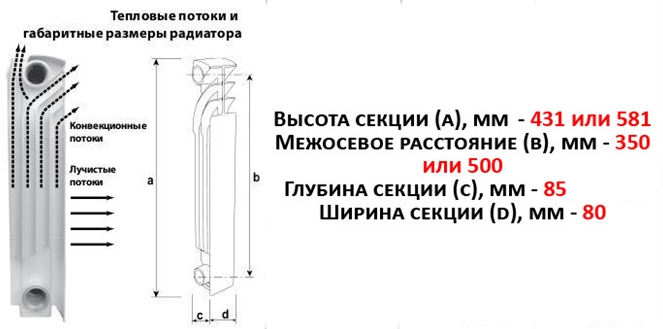 Rice. 3
Rice. 3Selection of thermal power
The technical characteristics of the bimetallic radiator correspond to each other, namely this thermal power(W) and center distance:
- 100 W – 20 cm;
- 100-145 W – 30 cm;
- 120-140 W – 35 cm;
- 179-200 W – 50 cm.
Thanks to this technical characteristic, you can find out how many sections specific model a radiator needs to be purchased.
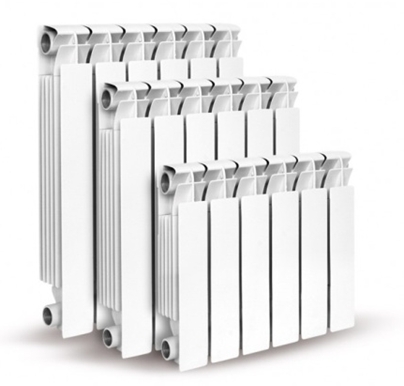 Rice. 4 Bimetallic radiators of different
Rice. 4 Bimetallic radiators of different sizes
Calculation
Since the cost of these heating devices is quite high, it is important to correctly calculate the quantity required sections so as not to overpay.
For this calculation you will need the following information:
- Room area (m2) - S;
- The power of one section of a specific radiator model is N;
Thus, the formula looks like this: (S* 100)/N= number of sections (pcs.).
For example, the room is 15 m2, and the power of one battery section is 160 W. Calculation: (15*100)/160=9.3.
The resulting number must be rounded to higher value, that is, it turns out that according to these parameters you need 10 sections of a bimetallic heating device. But you should also take into account the number of windows in the room; if there are more than one, then 1-2 sections should be added. It is better, of course, to contact qualified specialists, which will make the correct calculation, taking into account all technical specifications and heat loss at home.
At one time, the choice of batteries was not only limited, it was non-existent. They were produced only, for lack of an alternative, which were considered the most reliable and beautiful (especially if painted in a non-standard color). With the advent of radiators, it became clear that there are more durable models.
The release was another revelation - batteries can be lightweight and aesthetically pleasing. The invention of two-component heating devices proved that all the advantages can be combined into a single whole.
By design it is steel pipeline in an aluminum shell (fins). It is in this “duality” that their main advantage lies.
Combining the inherent steel strength and inertness to chemical reagents with the increased rated power of aluminum resulted in lightweight, aesthetically pleasing, durable devices that quickly warm up the air.
There are two types of bimetal radiators:

According to manufacturing technology, in addition to full-fledged, completely steel-based radiators, there are also so-called pseudo- or semi-metallic models. They are simply reinforced with steel tubes located in vertical channels.
Pseudo-metallic batteries are lighter, cheaper, but do not have the long service life, reliability and durability of real bimetal.
Options
Bimetallic heating radiators should be selected according to technical characteristics, which we will discuss in detail in this subsection.
Pressure
On average, bimetallic equipment is capable of withstand up to 35 - 40, and individual samples, in particular monolithic models, up to 100 atmospheres.
For heating systems in private houses low levels of 16 - 20 atmospheres are sufficient. For centralized ones, more are optimal high values, as there is a risk of pressure changes.
Heat dissipation
 The heat transfer coefficient of two-component radiators is increased due to the swirling air flow created by the thoughtful design of the fin shape. And a precisely calculated step creates good air draft. The default characteristics of sectional radiators indicate the power of one section.
The heat transfer coefficient of two-component radiators is increased due to the swirling air flow created by the thoughtful design of the fin shape. And a precisely calculated step creates good air draft. The default characteristics of sectional radiators indicate the power of one section.
Dimensions
The main part of the products has standard dimensions. Most Popular with center distance 500 and 350 mm. The total height is calculated using the formula “center distance plus eighty.”
Since the center distance is equivalent only to the segment between the centers of the collectors, the height of the remaining elements is added to it, equal to 80 mm.
Some manufacturers produce radiators with non-standard values - 200 (Russian Rifar, English Bilux, Italian Sira), 800 mm (Sira).
Temperature
With small volumes of coolant (150 - 380 ml per section), bimetal equipment heats up in just a few minutes and can withstand coolant temperature up to 130°.
Complexity of installation and durability
Installation as simple as possible. No special equipment or professional knowledge is required. All necessary parts are included in the package.
Most manufacturers modestly declare the working life of bimetallic batteries to be 10 - 15 years, but in reality, with proper use, they can last up to 20 - 25 years, or even longer.
Advantages compared to other types
Upon objective examination, it turns out that bimetal equipment has many advantages with a minimum number of disadvantages.
- High power. Compared to or, the heat transfer of bimetallic batteries is at least three times higher.
- Light weight. Only aluminum is lighter than bimetal.
- No internal deposits. Smooth steel walls do not retain silt and other debris, which cast iron radiators cannot boast of.
- Strength. Models made of cast iron and pure aluminum are not able to withstand water hammer of such force as the steel core of bimetallic devices is designed for.
- Durability. Inertness to chemicals and coolant quality increases the service life of the bimetal. Aluminum does not have such properties.
- Corrosion resistance. Neither cast iron nor aluminum can compare with this indicator.
- Small coolant volume. In radiators made of other metals, water circulates ten times more, which means they heat up much more slowly.
Flaws
Among the technological disadvantages, if we do not take into account the relatively high cost, Only two can be distinguished:
- If in terms of rated power, then the latter have a higher heat transfer coefficient. Therefore, in those cases when the main selection criterion is the total heat flow, aluminum will be the best option.
- do not retain heat for as long, cooling a little faster.
Of those on sale, bimetallic products have the most optimal characteristics for both individual and centralized heating systems. They have absorbed the best that is found in batteries made from other types of metal.
The few problems that can arise during operation are more often associated with installation errors or manufacturing defects. To avoid trouble, You should not purchase products from unknown manufacturers, even at the most attractive prices.
Heating batteries from the manufacturer Sira are suitable for indoor installation for various purposes, which can be public or residential. The manufacturer of this equipment is located in Italy, and among other products it produces, bimetallic radiators Sira can be distinguished.
In the process of their production, technologies are used that ensure effective work equipment at low cost. The described devices are distinguished by the fact that they have high heat transfer, they are able to ensure the reliability of the heater and are resistant to pressure surges.
Reviews about radiators
If you decide to consider Sira bimetallic radiators, then the BI POWER H.500 brand model can be used as an example. It is a sectional product, which, according to consumers, has an affordable price, attractive appearance and good heat dissipation. One more excellent option, according to buyers, is GLADIATOR, which has a height of 500 mm. The cost of such a Sira radiator, reviews of which are worth reading, is optimal, and the thermal power is higher compared to similar models from other manufacturers.
The supplier gives a 15-year guarantee for its products, during which the radiator will not leak, and if this happens, the manufacturer will be ready to replace the product. According to the owners of apartments and houses who have already purchased Gladiator radiators, it can be said that they have an unusual appearance and excellent quality. In general, RS 500 Bimetal are premium batteries that are manufactured using a patented method.
The outer shell is made of aluminum, while the core is made of steel. It has high resistance to various influences. This also includes coolant of poor quality. The filling is reliably protected by an aluminum case from negative impacts, in addition, the bimetallic design contributes to efficient process heat exchange, which is very popular with consumers. Sira bimetallic radiators are also good because their operating pressure reaches 40 bar. Such indicators are not characteristic of any product from competitors. The series presented on the market (RS Bimetal, Gladiator and Bi Power) are combined high quality, efficiency, modern design, safety and reliability.
Consumers especially emphasize that the battery does not have sharp edges, which is important when there are children in the family. You can purchase a battery limited to the number of sections ranging from 4 to 10. The lineup is quite wide, so consumers like that they can choose equipment to fit almost any window sill height.
Feedback on operational features
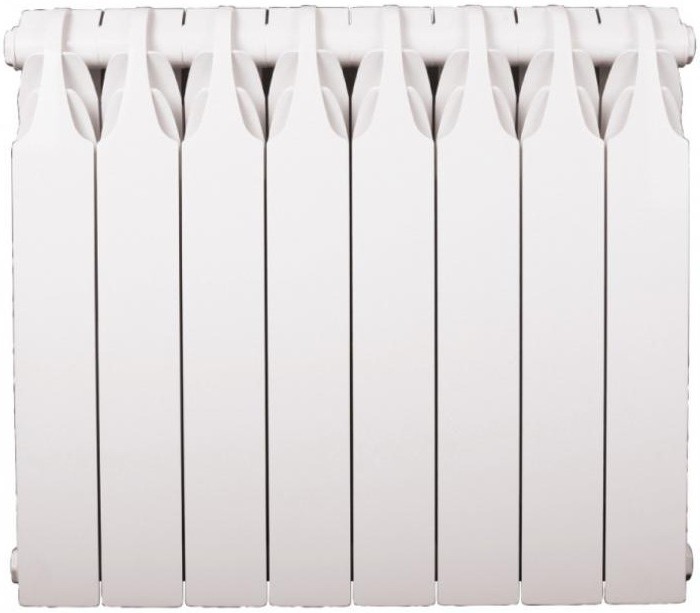
Consumers who have already enjoyed the qualities described by the radiator note that after installing batteries in winter, the rooms become much warmer than before. When replacing steel batteries, the average temperature becomes higher. In addition, according to buyers, the interior of the room can be made more attractive. The number of sections may be smaller, but the volume of heat released will be 2 times greater.
Sira radiators, according to property owners, can be replaced when there is a need to get rid of old cast iron radiators. If you want the equipment to last as long as possible, then the described option will be the best solution. The devices, according to consumers, meet all requirements. They have good heat dissipation and have high-quality coating which holds securely even when there is water inside high temperature. Sira radiators, as practice shows, work without any complaints.
Reviews on why you should choose bimetallic radiators
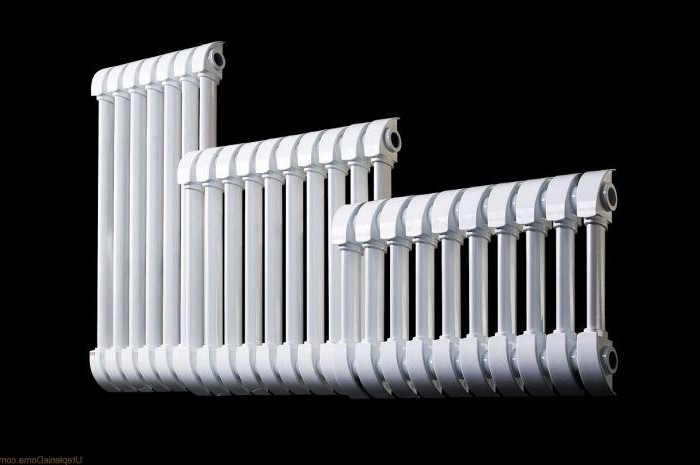
Bimetallic products for space heating are the pride of the company. The technology involves the use of two metals that are almost never combined. They became one unit in one device and turned out to be truly popular.
There is steel inside, which is in contact with the coolant and transfers heat to aluminum body. As a result, it is possible to obtain a device that, according to consumers, is reliably protected from alkali and corrosion. Buyers like that the described equipment efficiently heats rooms, at the same time, the device is very convenient to use and is lightweight.
Sira radiators have another important feature, which is expressed in durability. Compared to other companies, the described supplier provides a fairly long warranty. Consumers emphasize that other suppliers usually provide a ten-year warranty.
Technical characteristics of the model R. S. 300 BIMETALL

The above-mentioned equipment model has a section height of 372 mm. As for the width, it is 80 mm, while the depth is 95 mm. These parameters allow the installation of batteries in rooms with small window sill openings.
The heat output of the device is 142 W. As for connecting to the system, it is important to take into account the acidity of the coolant, which can vary from 6.5 to 9 pH. The temperature should not exceed 110 °C. The center distance is 300 mm. This Sira radiator is painted with powder enamel, which is called pseudo-ceramics. One section can be purchased for 750 rubles.
Characteristics of models R.S. 500 and 800

The best-selling model from the described series is R. S. 500. It has standard parameters that allow installation of equipment in any room. In this case, the space will be fully heated, and the device will not take up extra space.
The height of the radiator is 578 mm. One section provides heat transfer within 199 W. As for the distance between sections, it is stated in the marking and is 500 mm. For one section you will have to pay 720 rubles. minimum. If you are interested in other technical parameters, they remain the same as those of the device described above.
The heating radiator R. S. 800 does not take up much space in width. The height of one section is 880 mm, while the heat output is 280 W. Center distance 800 mm. For one section you will have to pay 1200 rubles.
Characteristics of the Gladiator series radiator

The Gladiator 200 model is budget, because it has low technical indicators compared to other series. One section has a power of 92 W. Height and depth are 275 and 80 mm respectively. The center distance is clear from the name.
The maximum operating pressure is slightly lower and equal to 30 atmospheres. Appearance models of this series differ more interesting design. The upper part smoothly turns into petals, which play the role of decoration and are an auxiliary tool for improving heat transfer. Such a heating battery will cost you 530 rubles.
Characteristics of Gladiator 350 radiators
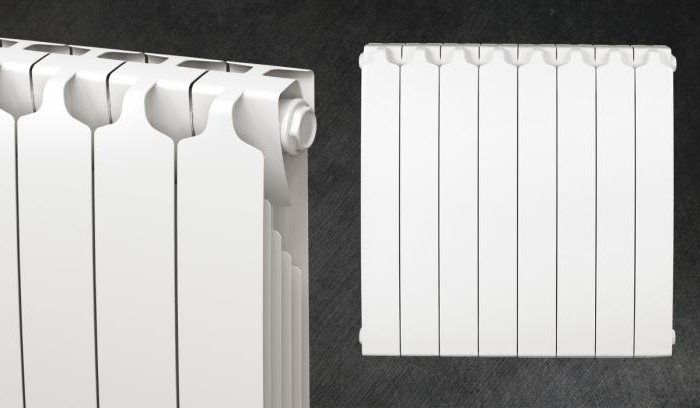
The height of the first of the mentioned models is 423 mm. The distance between the axles is 350 mm. Each section is capable of providing heat transfer within 142 W. In all other respects, the radiator is almost no different from the Gladiator 200. Even the cost of these models is identical and amounts to 540 rubles.
Characteristics of Gladiator 500 radiators
If you are interested in Sira heating radiators, then you should take a closer look at the Gladiator 500 model. It can be called the most popular among different segments of the Russian population. This is due to the versatility of the parameters, high quality and affordable cost. The height reaches 573 mm, as for the center distance, it is equivalent to 500 mm. One section has a power of 185 W. You can purchase this battery at an affordable price, which is 550 rubles. for one section.
Specifications Sira Concurrent
This series is the newest, therefore it is represented by only one model - Concurrent 500. It includes best qualities and design solutions. The product has an interesting design and ribbed side structure.
The compartments have different lengths. Thus, the heating radiator sections look attractive and unusual, and also provide additional heat transfer. The height reaches 565 mm, while the depth is 80 mm. The heat output of one section is 190 W. In other respects, the model corresponds to Sira RS radiators.
Conclusion
Bimetallic radiators become Lately increasingly popular. They are good because they can be used in heating systems with aggressive water. When it comes time to replace old steel and cast iron batteries, there is an opportunity to think about what material to buy radiators from. Bimetallic products have quite a lot of positive features, which are selected for power, heat transfer and ability to withstand a certain pressure.
